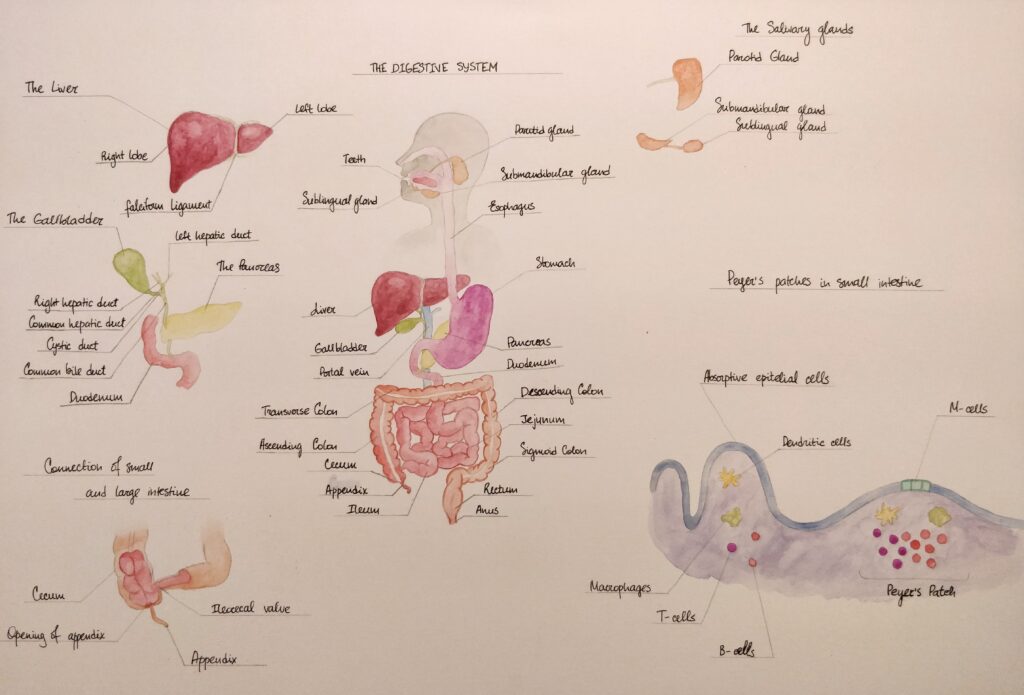
by Quantum Botanicals Advanced student, Kylie Williams
The gut microbiota is a complex ecosystem of it’s own, which has a heavy influence on overall health. This article looks at the effects of phytochemical on gut health, based on a summary of scientific studies collated in 2022. (See references below)
The gut microbiota has a role in:
- Digestion
- Absorption
- Overall health
Phytochemicals & Gut Microbiome
Plants secrete phytochemicals which accumulate in the cell wall and cell sap compartments of the plant, to aid the plants development and survival.
Phytochemicals are non-nutrient biologically active plant components that can modify the composition of gut microflora through selective stimulation of proliferation or inhibition of certain microbial communities in the intestine.
They are received into the body and recognised as xenobiotics. They are poorly absorbed in the small intestine, rather they enter the large intestine and reside there as their absorption is low. Then they are metabolised by gut bacteria. Their action on gut bacteria is being studied and is a relatively new area of research with some contradicting results, however many studies conclude and agree on the following:
- Phytochemicals can alter the composition of microbial ecology beneficially, by acting as prebiotics.
- Phytochemicals often have anti-microbial actions in the gut against harmful gut microbiota.
- Phytochemicals influence bacterial quorum sensing, allowing increases in the abundance of healthy bacteria. This may also interfere with signalling pathways involved in the process of disease development.
- Phytochemicals may have inhibitory action on unhealthy bacteria such as Helicobacter Pylori. Eg the action of polyphenols including green tea and red wine have shown to suppress production of toxin VacA (Vacuolating toxin A) which is a primary virulence factor of Helicobacter Pylori. This results in destruction of bacterial cell membranes, suppression of urease activity and disturbance of bacterial multiplication.
The table below visually demonstrates the effects of phytochemicals on the gut health and function.
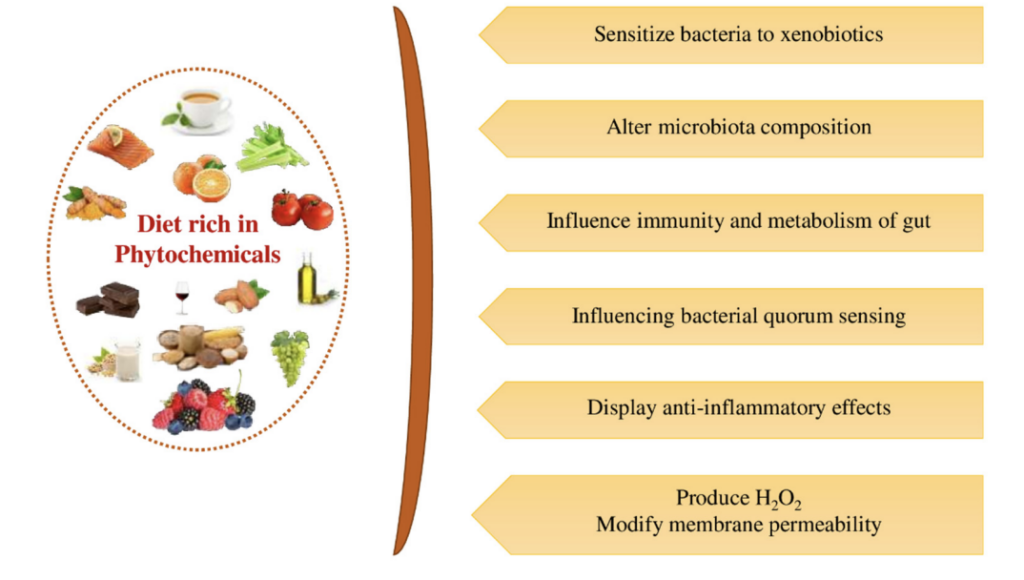
(From The Impact of Plant Phytochemicals on the Gut Microbiota of Humans for a Balanced Life, Sarusha Santhiravel 1,2,* , Alaa El-Din A. Bekhit 3, Eresha Mendis 4, Joe L. Jacobs 5,6 , Frank R. Dunshea 7,8, Niranjan Rajapakse 4 and Eric N. Ponnampalam 9,*)
The kingdom of gut bacteria resides in each and every one of us and is one of the most densely populated and diversified bacterial eco-systems in nature. Known as our gut microbiome, it consists of mainly of anaerobic bacteria, then also fungi, protozoa and viruses. It resides in the large intestine and is involved in the fermentation of of undigested food particles, including fats, carbohydrates and proteins.
In a healthy state this contributes to overall health and wellbeing, however in an unhealthy state it has the opposite effect. Around 400BC Hippocrates is said to have quoted “Death sits in the bowels”.
There are around 100 trillion bacteria, and approximately 1000 different species have been identified. The surface area of the human GI tract is between 260-300m square. This complex system used to be considered as simply an excretion system in medical science, however it is now considered an essential organ of health.
The types and numbers of microbes varies along the GI tract. In the first portion of small intestine (the duodenum) the PH is similar to that of the stomach and the population of gut microbes in significantly less than further along into the large intestine, where PH increases (5.7 – 6.8). There should be a more concentrated, complex and diverse microflora community here. This is also affected by the composition and physiology of both the lumen and mucus layer of the intestinal tract.
From birth until approximately age 3, we have an important role to play in influencing a healthy microbiome. At age 3 the phylogenic diversity of microflora is established and a stable and complex microbial ecosystem is generated.
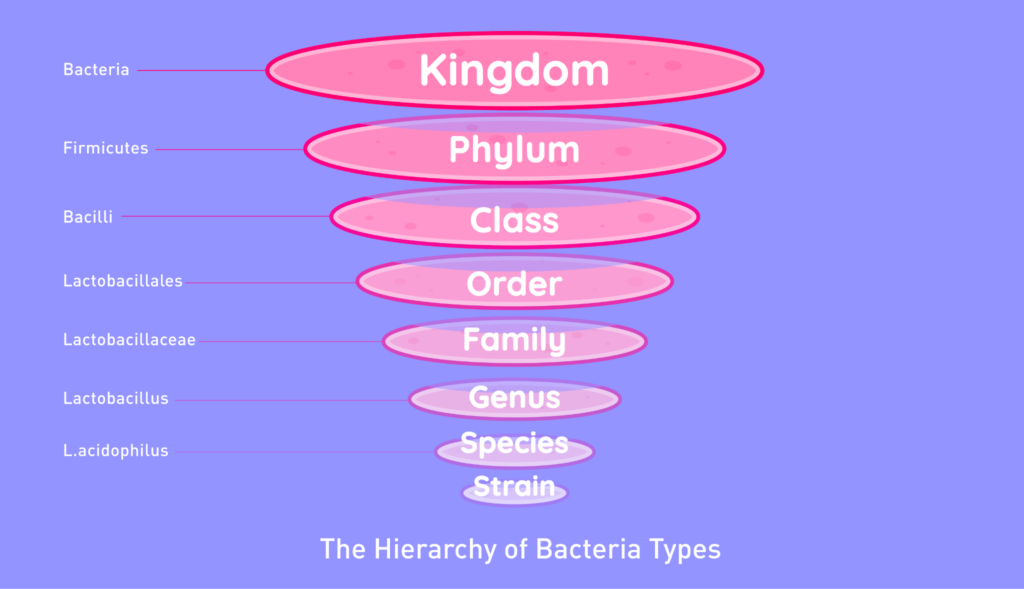
https://atlasbiomed.com/blog/guide-to-firmicutes/
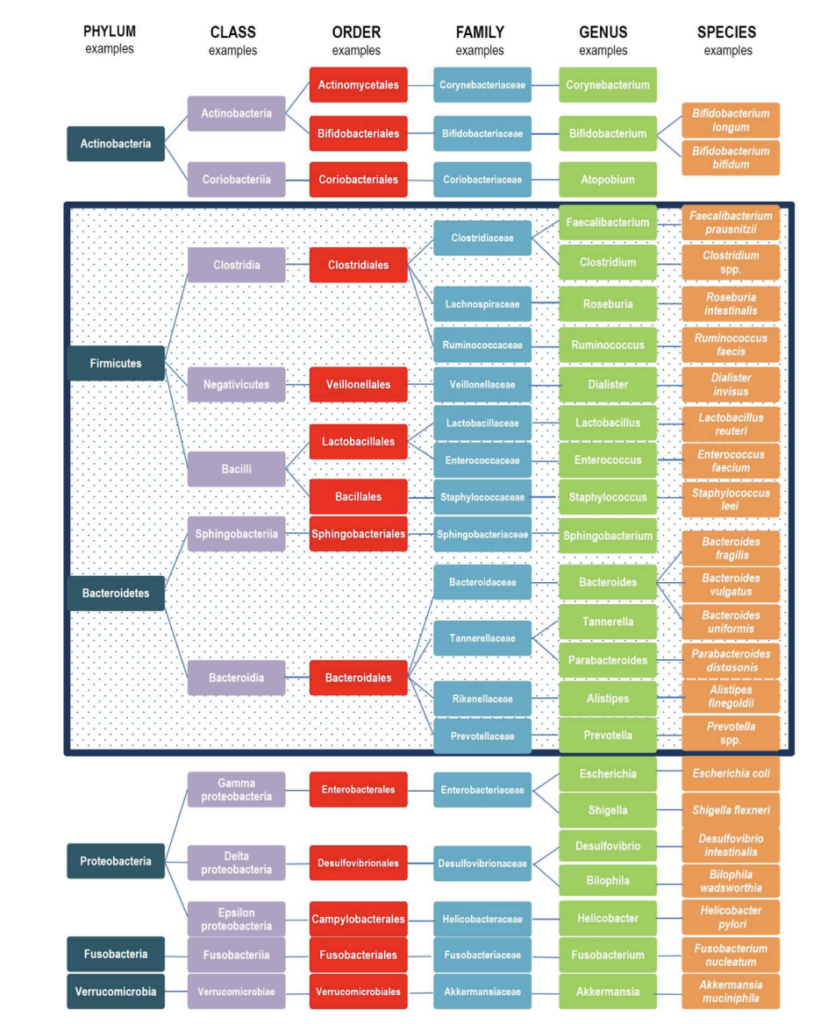
Examples of taxonomic gut microbiota composition. In the box are cited examples of bacteria belonging to Phyla Firmicutes and Bacteroidetes, representing 90% of gut microbiota. From https://www.ncbi.nlm.nih.gov/pmc/articles/PMC6351938/pdf/microorganisms-07-00014.pdf
Firmicutes play a significant role in the in the relationship between gut bacteria and human health. They break down carbohydrates in the gut that can’t be digested by the bodys enzymes (eg. dietary fibre and resistant starch) by fermentation.
This produces metabolites including vitamins and short chain fatty acids like butyrate. Butyrate helps to prevent inflammation and fuels the lining of the gut to maintain a healthy colon.
Butyrate
- Is a source of energy for the cells of the gut lining
- Stimulates glutathione production
- Helps prevent cancer by preventing cancer cells from developing
- Encourages hormone production for healthy metabolism
Studies have shown a relationship between the ratio of firmicutes:bacteriodetes and body weight/obesity. Obesity is associated with higher amounts of firmicutes and lower bacteriodetes, however there are limited studies to support this. We do know that flavones help to improve this relationship.
There are also studies which correlate lower levels of butyrate with people experiencing IBS symptoms.
Prebiotics (fibres and starches that the body can’t easily digest) are a source of energy for firmicutes and these include fruits, vegetable, legumes and whole grains. Hence supporting these will help to increase butyrate.
Foods that have a negative effect on the health of the gut microbiota include those high in animal protein, fat and sugar.
Gut Health and Metabolic Disease
Colonic microflora shows an interaction with metabolic diseases. The intestinal eco-system contributes heavily to optimum human health by contributing non-human genome encoded enzymes, including the generation of vitamins and the breakdown of phytochemicals to form metabolites that contribute to human health.
The intestinal microflora may be responsible for the cause of metabolic disorders including obesity, hypertension, cardiovascular disease, diabetes and inflammation.
The intestinal microflora have been found to play significant roles in the human physiology including:
- Regulation of colonic function
- Immune system modification
- Toxin removal from the body
- Defense against several pathogens
- Energy homeostasis, which is interrelated with insulin resistance and obesity.
- Alter the signalling pathways associated with the initiation and progression of inflammation
Some studies have found that chronic low grade inflammation is generated by the interaction between a persons diet and their intestinal microbiome. There is a reciprocal association between the diet and gut microbiome. Phytochemicals in food form part of this picture, as do vitamins, minerals, dietary fibre, fats, eating a toxin/additive free diet and lifestyle factors such as exercise and a balanced stress response.
Conversely, in an unbalanced or unhealthy state the gut microbiota plays a negative role in health and may be one of the factors contributing to dysbiosis, as well as diet, insufficient exercise, stress, age, drugs, metabolic factors. Dysbiosis and disease are closely related and affect overall health. In the GI tract dysbiosis can lead to digestive conditions such as:
- IBD
- Chrons Disease
- Ulcerative Colitis
- Colorectal cancer
Dysbiosis may also lead to disorders associated with ‘extra metabolism’ such as:
- Diabetes
- Obesity
- Cardiovascular Disease
- Related micro and macrovascular complications
However it should be noted that the term ‘dysbiosis’ has no official definition as yet so it’s not actually possible to define what dysbiosis is for all people. We do use the term to refer to an altered state of health in the digestive system, where some or all of the following factors may be an affected:
- Intestinal permeability
- Gastrointestinal motility
- Visceral hypersensitivity
- Gut microbiome factors
- Gastrointestinal immune system
Paying attention to gut health through diet, exercise and beneficial changes to PH can help the favourable bacteria (symbionts) to thrive, whilst removing pathogenic bacteria (pathobionts). This is one of the factors that contribute strongly to gut health, and consequently whole body health.
Gut Health and Phytochemicals
Phytochemicals from plants have a powerful role to play in supporting a healthy microbiome. Phytochemicals have the ability to ‘selectively’ encourage the growth of some bacterial populations in the gut, known as ‘probiotics’, which include yeast, bifidobacterium, lactic acid bacteria and bacilli involved in metabolism.
Phytochemicals also play a role in inhibition of gut dysbiosis by enhancing the prevalence of several species of beneficial bacteria and by enhancing diversity of microflora. They also reduce the abundance of opportunistic harmful bacteria. These combined effects support intestinal barrier function and reduce the likelihood of gut dysbiosis. This results in decreased metabolic diseases and their related complications.
The illustration below shows the impact of phytochemicals on metabolic diseases.
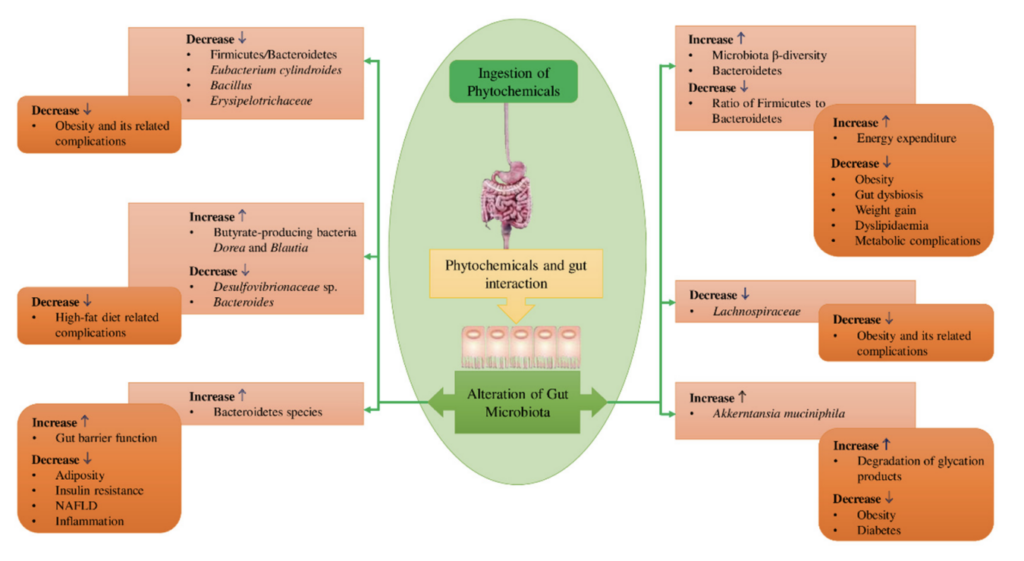
(From The Impact of Plant Phytochemicals on the Gut Microbiota of Humans for a Balanced Life, Sarusha Santhiravel 1,2,* , Alaa El-Din A. Bekhit 3, Eresha Mendis 4, Joe L. Jacobs 5,6 , Frank R. Dunshea 7,8, Niranjan Rajapakse 4 and Eric N. Ponnampalam 9,*)
Phytochemicals however are just part of the picture for gut health. Before we go into the specifics of research on phytochemicals it is important to remember that gut health is influenced by many more aspects of diet and lifestyle, including minerals, vitamins, essential fatty acids, overall diet ph, stress, hydration etc.
The next section looks at some of the results of studies on the effects of phytochemicals on gut health. All phytonutrients have anti-oxidant and anti-inflammatory benefits.
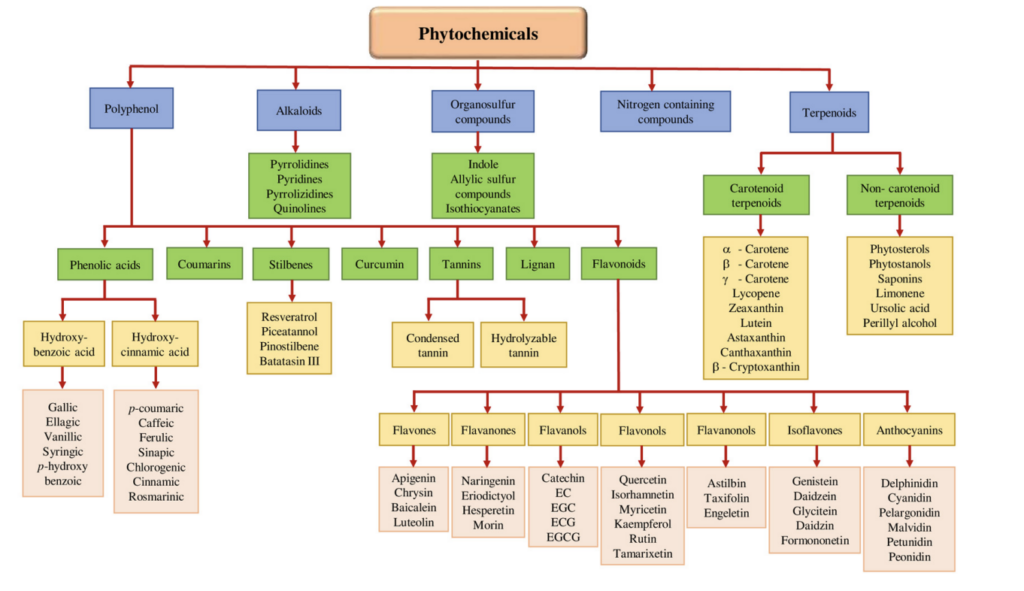
Classification of Dietary Phytochemicals. From The Impact of Plant Phytochemicals on the Gut Microbiota of Humans for a Balanced Life. Sarusha Santhiravel 1,2,* , Alaa El-Din A. Bekhit 3, Eresha Mendis 4, Joe L. Jacobs 5,6 , Frank R. Dunshea 7,8,Niranjan Rajapakse 4 and Eric N. Ponnampalam 9,*
Polyphenols
Polyphenols are categorised into either flavonoids (flavones, flavanones, flavanols, flavonols, flavononoles, isoflavones) and non-flavonoids (phenolic acids, stilbenes, curcumin, tannins, lignans, coumarin).
They have low bio-availability and their health benefits occur due to the metabolites of their interaction with the gut microbiota, which in turn alter the intestinal microbiome eco-system.
Flavonoids:
More than 6000 flavonoids have been identified, most notably containing pigments that give colour in flowers and plants. They act as free radical scavengers.
Flavones:
Pigments in blue and white flowering plants, and a natural pesticide.
Includes: parsley, red peppers, celery, chamomile, peppermint, corriander.
- Lower the ratio between firmicutes and bacteriocidetes. This has been shown to help weight loss.
Flavanols:
Foods with this type of flavonoid are very rich in nutrients. Includes: white tea, green tea, black tea, apples, grapes, blueberries, strawberries.
Present in higher concentrations in fruit skin as opposed to the pulp.
- Diets high in flavonols may help gut bacteria by acting as prebiotics and having a therapeutic effect at modulating the eco system.
- A flavanol called catechin (high amounts in green tea, strawberries, blackcurrents, bilberries) which has strong anti-cancer action. It Improves intestinal permeability and the tight junctions. Improves cell signalling. Promotes beneficial bacteria.
Flavonols:
Found in: onions, kale, grapes and red wine, tea, peaches, berries, tomatoes, lettuce, broccoli.
The flavonols studied most include quercetin and kaempferol. This group also includes myricetin and rutin.
Quercetin: Black elderberry (42), Oregano (42), capers (32), cloves (28), dark chocolate (25), champagne (8), tomato (5)
Kaempferol: capers (104), cumin (38), cloves (23), tea (6), apple (4)
- Significantly improve Lactobacillus, bacteriodes, bifidobacterium, clostridia.
- Suppress the multiplication of gut bacteria related to diet induced obesity, including E.Cylindroides and Erysipelotrichasceae.
Flavanones:
Found in: citrus fruits are the main source, also mint and tomatoes
- Suppress growth of harmful microbes
- Activate beneficial microbes
- Can alter the function and composition of the intestinal ecosystem
- Hesperidin (citrus fruits) has shown to increase populations and abundance of lactobacillus
- The ratio between butyrate and short chain fatty acids was increased by supplementing with 500mg of a citrus extract
Isoflavones:
Their chemical structure resembles that of an estrogen steroid hormone. Isoflavones have estogenic activity in the body.
Found in: soy, legumes (lentils, beans, peas)
- In a study on post menopausal women after administration of soy isoflavones all subjects showed significant increase in bifidobacteria, with a corresponding decrease in lactobacillus. Another study showed increases in all, and in healthy firmicutes in general.
Anthocyanins:
Responsible for the red, purple and blue colours of fruits and vegetables.
- Gut microbiota convert anthocyanins to their metabolites. This happens in the large intestine. In turn the metabolites alter the composition of the gut ecosystem by altering the abundance of bacteria.
- Favourable bacteria are increased such as lactobacillus and bifidobacterial strains. The less favourable are decreased.
- Total numbers of bacteria may stay the same, however the ratio of good to bad improves.
- Further studies combining mixed anthocyanins with prebiotics shows favourable results in improving the intestinal community of microflora.
- The action against harmful bacteria occurs as healthy bacteria compete for adhesion sites and growth substrate and then produce short chain fatty acids, feeding into a healthy ecosystem.
- Pathogenic bacteria are decreased, which are responsible for inflammatory bowel disease and turmor inducing actions. Effective against H.Pylori.
- Also prevent collagen breakdown which in turn reduces the broken down amino acids feeding into bacteria in the oral cavity, improving oral health.
Stilbenes:
Resveratrol:
Food sources: muscadene grape red wine (3), cranberry (1.92), strawberry (0.35), red wine (0.27), black grape (0.15), white wine (0.04). Also bilberries and peanuts.
- Anti-diabetes, anti-oxidant, anti-obesity, improve colonic microorganisms.
- Reduces body fat and body weight by stimulating alterarions in the colonic microflora.
- Improves atherosclerosis through modifications of gut bacteria
- Promotes multiplication of lactobacillus and bifidobacterim
- Prevents the ‘virulence’ factors of proteus mirabilis
Piceatannol
Food Sources: black grapes (5.2) red wine (0.58)
- Significantly alters gut bacteria, reducing unfavourable bacteria and increasing favourable.
Lignans
Phytoestrogens contained in approximately 70 different plants. Main sources include flax seeds, oil seeds and grains.
- Estrogen like activity isn’t found in the lignans themselves, but occur once metabolised by gut bacteria, producing entero-lignans including enterolactone and enterodiol.
- Improves the anti-oxidant status of tissue systems and the whole body
- Prevents cancer by limiting the proliferation of cells via anti-carcinogenic effects.
- Improves immunity by providing defence against infections.
Tannins
Widely distributed in nature. Proteins can be precipitated by tannins.
- The anti-microbial nature of tannins has been demonstrated in studies
- Pomegranate has shown to accelerate the total number of gut bacteria
- Pomegranate elligitannins and urolithin A (their major metabolite) are produced by the microbiota and increases the prevalence of lactobacteria and bifidobacteria.
Condensed tannins (pro-anthoycyanidins)
- Contribute to the purple, red or blue colours of flowers, fruits or leaves
- Studies show shifts in the gut bacteria when consumed.
Curcumin:
Extracted from the turmeric rhizome (2213 mg/100g), numerous studies have shown curcumin has a beneficial effect on intestinal microbiota communities.
- In oestrogen deficiency the microbiota community is affected. Curcumin has shown to re-establish the gut microbiota.
- It has also shown to increase bacteria-generating butyrate.
- Stimulates anti-inflammatory NF-kB in epithelial cells of the intestine and inhibits mucosal mRNA expression of inflammatory mediators.
- In animal studies curcumin supplementation has shown to incrase proportions of anti-inflammatory lactobacilli and bifidobacteria, reducing pro-inflammatory bacteria such as enterococci and enterobacteria.
- Proliferation, growth and existence of beneficial microbes in the intestines is promoted by curcumin.
Phenolic Acids
Phenolic acids are split into 2 groups; Hydroxybenzoic Acid and Hydroxycinnamic Acid.
Good food sources include white grapes, berries, bran, brown rice, olive oil, gooseberries, onions, plums, almonds, wholegrains and wine.
Caffeic Acid:
Food Sources:. Sage dried (26), spearmint dried (25), cinnamon (24) thyme dried (21) (interestingly more when dried than fresh) Cinnamon (25) Other foods sources include coffee, red wine, berries, apples, olives, artichokes, and pears.
- Caffeic acid has shown to enhance the abundance of Akkermansia, a probiotic which shows beneficial effects for obesity and diabetes especially. It suppresses the rise in the the ratio between firmicutes and bacteriodetes.
Proteocatechic Acid
Found in: star anise (32), chicory (21), olives (6)
- Lowers the abundance of inflammatory microbes such as helicobactor, mucispirillum and lachnospiraceae.
- Increases firmicutes and actinobacteria that are beneficial to gut health
- Reduces proteobacteria and bacteriocidetes that have pro-inflammatory effects
Ellagitannins
Found in: pomegranates, grapes, walnuts, berries
- Campylobacter jejuni and Candida albicans species, are notably susceptible to cell wall degradation by ellagitannins.
Organosulfur compounds
(indoles, isothiocyanates, allylic sulfur compounds)
- Garlic is the richest source of organosulfur compounds. It produces defense compounds and has wide ranging anti-microbial properties
- Ingestion of whole garlic increases diversity of species of the gut microbiome
Carotenoids
Carotenoids contribute to the red, orange and yellow colours of fruit and vegetables.
They are split into 2 groups:
- Carotenes: lycopene, 𝛼 carotene and β carotene.
- Xanthophylls: zeaxanthin, lutein, meso zeaxanthin
In the blood carotenoids have poor bio-availability. The gut microbiota ferment them once they enter the colon.
- Act as antioxidants at low concentrations. At high concentrations can be toxic.
Astaxanthin
Found in marine animals, shrimp, salmon, microalgae
- In helicobacteria-pylori astaxanthin is shown to reduce bacteria and reduce inflammation
- Liver health: Astaxanthin supplementation has shown to relieve inflammation of the liver, and reduce excessive accumulation of lipid and serum markers of liver injury.
Lutein
- Prebiotic activity, remarkably increases abundance of lactobacilli and bifidobacterium.
Lycopene
Is a red pigment, eg. in watermelon, tomatoes and other fruits
- Alters the composition of colonic microflora by promoting abundance of Bacterium Longum and Bacterium Adolescentis.
Other factors which positively benefit the health of the gut microbiome include:
Exercise: exercise has shown to improve the tight junctions of the epithelial tissue of the the digestive tract.
NB. The phytochemical properties of many herbs increases greatly when the herb is dried.
References:
The Impact of Plant Phytochemicals on the Gut Microbiota of Humans for a Balanced Life. Sarusha Santhiravel 1,2,* , Alaa El-Din A. Bekhit 3, Eresha Mendis 4, Joe L. Jacobs 5,6 , Frank R. Dunshea 7,8,Niranjan Rajapakse 4 and Eric N. Ponnampalam 9,*, Eresha Mendis 4 , Joe L. Jacobs 5,6 , Frank R. Dunshea 7,8, Niranjan Rajapakse 4 and Eric N. Ponnampalam 9,*
Talk by Ben Brown: Nutritional Gastroenterology: Matching New Treatments to New Disease Subtypes (June 2023)
http://phenol-explorer.eu/